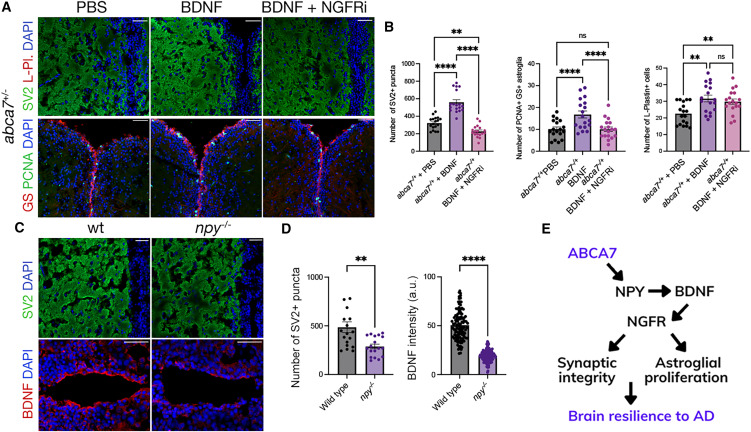Fig. 7 ABCA7-dependent NPY acts through BDNF/NGFR axis (A) Immunofluorescence for SV2/L-plastin and GS/PCNA with DAPI counterstain in abca7+/? knockout brains injected with vehicle (PBS), BDNF, and BDNF + NGFR inhibitor. (B) Quantification graphs for SV2+ puncta, number of PCNA/GS double-positive astroglia, and number of L-plastin+ microglia. Inhibition of NGFR abrogates the rescue effects of BDNF on synaptic integrity and astroglial proliferation. Two-way ANOVA with Tukey?s multiple comparison test was used for statistical analyses. n = 4 animals from both sexes, with 18 brain sections per group. (C) Immunofluorescence in npy?/? knockout animals for SV2 and BDNF with DAPI nuclear counterstain. (D) Quantification of the number of SV2+ synaptic puncta and BDNF intensity. npy?/? knockout independently reduces BDNF expression and the synaptic integrity. n = 3 animals from both sexes and 18 brain sections per group. (E) Activity model for ABCA7: ABCA7-dependent induction of NPY after amyloid toxicity is required for expression of BDNF, which?through NGFR?regulates the synaptic integrity and astroglial proliferation. ABCA7 function is relevant to brain resilience to AD in an NPY-dependent manner. ?p < 0.0332, ??p < 0.0021, ???p < 0.0002, ????p < 0.0001; not significant (ns), p > 0.0332. Scale bars, 50 ?m. See also Figures S1 and S4 , Data S1 and S3 , and Table S1 .
Image
Figure Caption
Acknowledgments
This image is the copyrighted work of the attributed author or publisher, and
ZFIN has permission only to display this image to its users.
Additional permissions should be obtained from the applicable author or publisher of the image.
Full text @ Cell Genom

